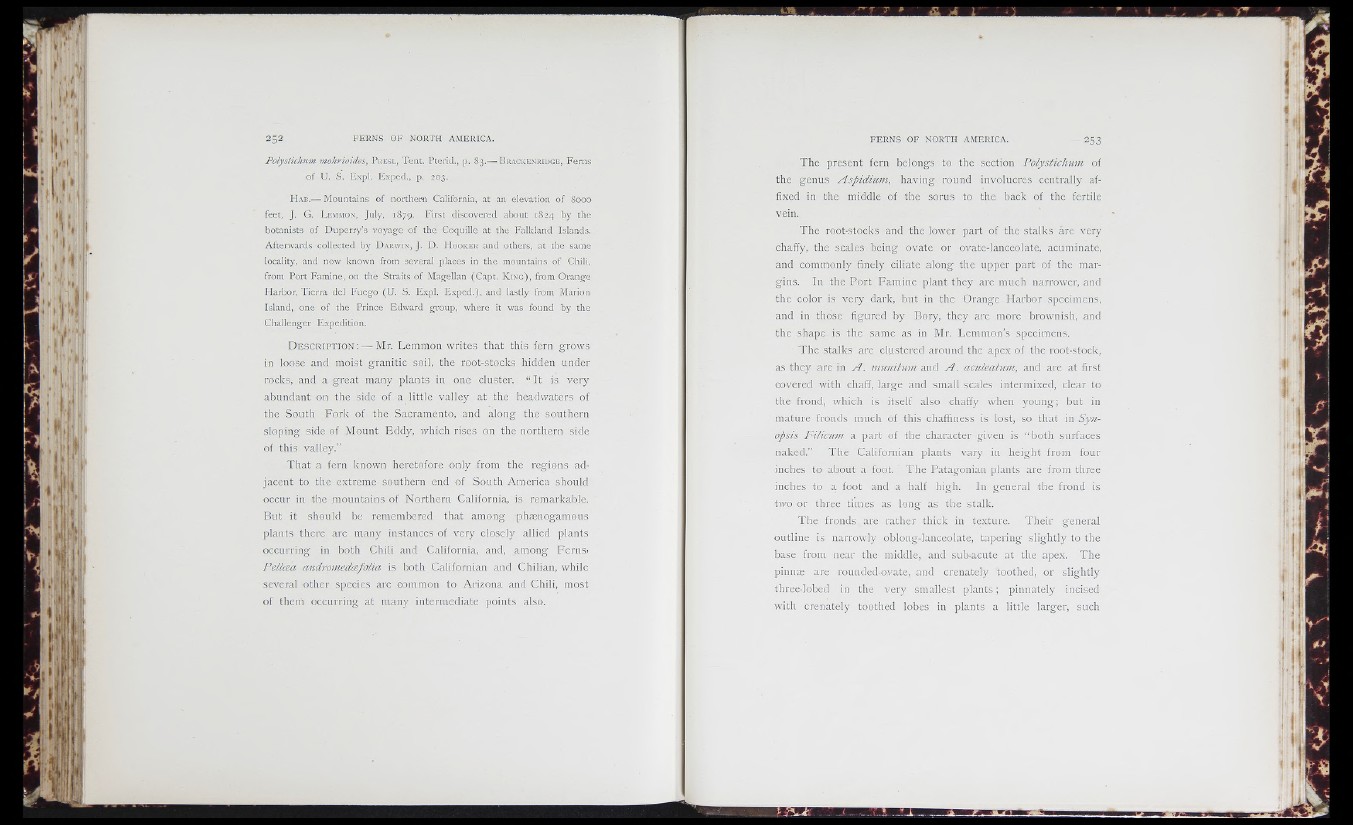
F E R N S OF NORTH AM E R IC A .
Polystichum mohrioides, P r e s l , Tent. Pterid., p. 8 3 .— B r a c k EíNr id g e , Ferns
of U. S, Expl. Exped., p. 203.
H a b .— Mountains of northern California, at an elevation of 8 0 0 0
feet, J. G. L emmo n , July, 1879. F'irst discovered about 1824 by the
botanists of Duperry’s voyage of the Coquille at the Falkland Islands.
Afterwards collected by D a rw in , J. D. H o o ker and others, at the same
locality, and now known from several places in the mountains of Chili,
from Port F'amine, on the Straits of Magellan (Capt. K in g ) , from Orange
Harbor, Tierra del Fuego (U. S. Expl. Exped.), and lastly from Marion
Island, one of the Prince Edward group, where it was found by the
Challenger Expedition.
D e s c r i p t i o n : — Mr. Lemmon writes that this fern grows
in loose and moist granitic soil, the root-stocks hidden under
rocks, and a great many plants in one cluster. “ It is very
abundant on the side of a little valley at the headwaters of
the South Fork of the Sacramento, and along the southern
sloping side of Mount Eddy, which rises on the northern side
of this valley.”
That a fern known heretofore only from the regions adjacent
to the extreme southern end of South America should
occur in the mountains of Northern California, is remarkable.
But it should be remembered that among phzenogamous
plants there are many instances of very closely allied plants
occurring in both Chili and California, and, among Ferns.
Pellcea andromedcefalia is both Californian and Chilian, while
several other species are common to Arizona and Chili, most
of them occurring at many intermediate points also.
f e r n s o f n o r t h AM E R IC A . 253
The present fern belongs to the section Polystickum of
the genus Aspidium, having round involucres centrally affixed
in the middle of the sorus to the back of the fertile
vein.
The root-stocks and the lower part of the stalks are very
chaffy, the scales being ovate or ovate-lanceolate, acuminate,
and commonly finely ciliate along the upper part of the margins.
In the Port Famine plant they are much narrower, and
the color is very dark, but in the Orange Plarbor specimens,
and in those figured by Bory, they are more brownish, and
the shape is the same as in Mr. Lemmon’s specimens.
The stalks are clustered around the apex of the root-stock,
as they are in A . immituin and A . aculeatum, and are at first
covered with chaff, large and small scales intermixed, clear to
the frond, which is itself also chaffy when young; but in
mature fronds much of this chaffiness is lost, so that in Synopsis
Filiczim a part of the character given is “ both surfaces
naked.” The Californian plants vary in height from four
inches to about a foot. The Patagonian plants are from three
inches to a foot and a half high. In general the frond is
two or three times as long as the stalk.
The fronds are rather thick in texture. Their general
outline is narrowly oblong-lanceolate, tapering slightly to the
base from near the middle, and sub-acute at the apex. The
pinnæ are rounded-OA’ate, and crenately toothed, or slightly
three-lobed in the very smallest plants; pinnately incised
with crenately toothed lobes in plants a little larger, such
I
i ii
A